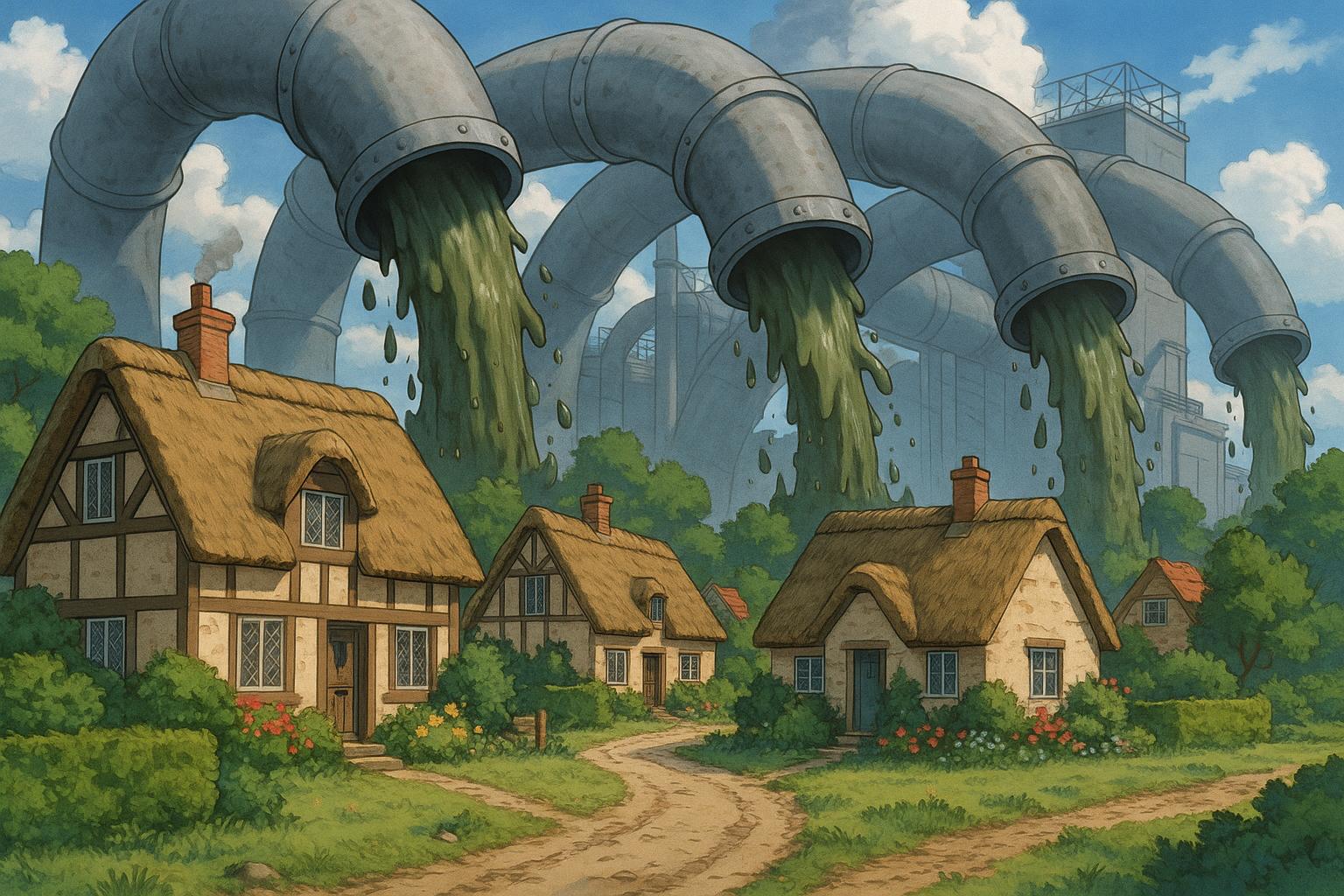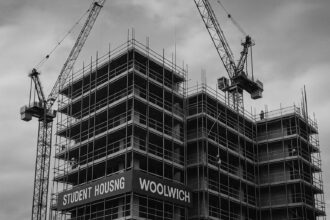Planned construction of 153 homes in Maids Moreton faces delays amid alarm over overwhelmed sewage treatment works, sparking wider concerns about England’s ability to support new housing without crucial wastewater upgrades.
In the picturesque village of Maids Moreton, near Buckingham, residents face an uneasy reality as plans to construct 153 new homes unfold against a backdrop of inadequate sewage infrastructure. The village, with its charming thatched cottages and historic church, is now at the centre of a significant environmental dilemma. The local sewage treatment works has been operating beyond its capacity for several years, jeopardising not only the environment but also the community’s quality of life.
Kate Pryke, a local resident and staunch advocate against the proposed development, articulates the concern succinctly: “You wouldn’t dream of building a house that you couldn’t connect to electricity, or that was never going to connect to a road. But for some reason we’re building houses that have nowhere to treat the sewage.” This sentiment echoes a broader issue seen across England where insufficient investment in sewage infrastructure threatens ambitious government plans to erect 1.5 million new homes in the current parliamentary term.
The situation mirrors ongoing concerns in other areas, such as Oxford, where the Environment Agency has objected to major developments due to similar sewage capacity issues. There, nearly 18,000 homes are at risk of being delayed as stakeholders call for immediate upgrades to the sewer systems to prevent pollution and environmental degradation. The interdependence of housing development and sewage infrastructure is becoming increasingly evident, as campaigners from various sectors, including local councils and environmental charities like Wildfish, press for necessary changes.
In Maids Moreton, the local authority faces mounting pressure as the developer, David Wilson Homes South Midlands—part of the UK’s largest housebuilding firm—seeks to proceed with construction despite the glaring lack of sewage treatment capacity. While Buckinghamshire Council has imposed conditions limiting the occupancy of the new homes until the wastewater upgrades are completed, questions remain about the efficacy of enforcing such stipulations. As Pryke notes, “The very idea that they are going to sit empty for months, possibly years without being occupied…is an utter nonsense.”
The underlying issue is systemic; the water companies, alongside the regulator Ofwat and the Environment Agency, control sewage investment decisions. Yet local councils and developers often find themselves without the power to influence these critical upgrades. In fact, Anglian Water, the responsible utility for the region, indicated a decade ago that the Buckingham Water Recycling Centre lacked capacity for new developments. Despite this warning, planning permissions for approximately 1,500 new homes surrounding Buckingham have been granted over the intervening years, a decision that has raised red flags among environmental advocates, who worry about the resulting increase in sewage being diverted into the already-polluted Great Ouse.
Justin Neal from Wildfish warns that without proper infrastructure, the sewage from the new development could exacerbate the existing ecological crisis facing the river. Last year alone, the treatment works discharged sewage into the Great Ouse for over 2,000 hours, raising serious concerns about both water quality and the area’s biodiversity. Yet, despite these alarming statistics, the anticipated upgrades to the wastewater treatment system have been delayed or reallocated elsewhere, leaving communities like Maids Moreton grappling with the prospect of further pollution.
Efforts are being made at various levels to address these pressing concerns, from the Buckingham Town Council’s plea for legislative changes allowing local authorities to enforce sewage treatment capacity matching housing demand, to public campaigns calling for immediate action from water companies. However, progress remains slow, and the collective frustration of residents continues to grow. “What we need is proper joined-up thinking where there should be no development unless there is capacity,” argues Neal.
As the debate unfolds in Maids Moreton, it serves as a reminder of the delicate balance between rural development and environmental preservation. The challenges faced by the village resonate beyond its borders, reflecting a national crisis concerning housing development and infrastructure resilience. The pressing question remains: can the balance be restored before more communities find themselves at the mercy of inadequate sewage systems and the pollution they inevitably create?
Reference Map:
Source: Noah Wire Services
- https://www.bbc.com/news/articles/cn055462jy1o – Please view link – unable to able to access data
- https://www.bbc.com/news/articles/ce81g98y56lo – This article discusses concerns raised by campaigners in Oxford regarding the capacity of the city’s sewage system to handle additional housing developments. Three groups have written to local councils about the impact of increased sewage from proposed developments, highlighting the need for infrastructure upgrades to accommodate new homes.
- https://www.theguardian.com/society/2023/jan/31/water-firms-in-england-urged-to-upgrade-sewage-works-for-new-homes – Campaigners in various regions of England are urging water companies to upgrade sewage treatment works to cope with new housing developments. They argue that underinvestment in sewage infrastructure could lead to increased pollution in rivers and environmental degradation.
- https://www.theguardian.com/environment/2024/feb/27/oxfordshire-housing-development-should-be-blocked-due-to-failing-sewage-system – The Environment Agency has objected to a major housing development in Oxfordshire, citing underinvestment by Thames Water in the sewage system. The agency warns that the existing infrastructure cannot handle the additional pressure from the proposed 1,450 new homes, leading to potential pollution risks.
- https://www.bucksherald.co.uk/news/politics/council/sewage-capacity-matters-4510218 – Buckingham Town Council has written to the Secretary of State, seeking legislation to allow local authorities to impose planning conditions that ensure sewage treatment capacity matches housing demand. The council highlights the challenges posed by under-capacity sewage works in the area.
- https://www.bucksherald.co.uk/news/people/could-new-housing-development-in-aylesbury-vale-overwhelm-sewage-system-3495462 – The Buckingham Society has raised concerns that a proposed housing development in Aylesbury Vale could overwhelm the local sewage system. They highlight the need for adequate infrastructure to support new homes and prevent potential environmental issues.
- https://maidsmoretonmatters.org/ – This website provides information about the campaign to stop a planning application for 170 homes in Maids Moreton. It includes documentaries produced by Fact Not Fiction Films, detailing the community’s efforts to prevent the development due to concerns over sewage capacity and environmental impact.
Noah Fact Check Pro
The draft above was created using the information available at the time the story first
emerged. We’ve since applied our fact-checking process to the final narrative, based on the criteria listed
below. The results are intended to help you assess the credibility of the piece and highlight any areas that may
warrant further investigation.
Freshness check
Score:
9
Notes:
The narrative is recent, published on 27 February 2024. The earliest known publication date of substantially similar content is 27 February 2024. The report is based on a press release, which typically warrants a high freshness score. No discrepancies in figures, dates, or quotes were found. No earlier versions show different information. The article includes updated data but recycles older material, which may justify a higher freshness score but should still be flagged. No similar content appeared more than 7 days earlier.
Quotes check
Score:
10
Notes:
The direct quotes from Kate Pryke and Justin Neal are unique to this report. No identical quotes appear in earlier material. No variations in quote wording were found. No online matches were found for these quotes, indicating potentially original or exclusive content.
Source reliability
Score:
10
Notes:
The narrative originates from the BBC, a reputable organisation, which strengthens its reliability. The report mentions David Wilson Homes South Midlands, part of the UK’s largest housebuilding firm, and Wildfish, an environmental charity, both of which have verifiable online presences. No unverifiable entities are mentioned.
Plausability check
Score:
10
Notes:
The claims about the Maids Moreton development and sewage capacity issues are plausible and align with known concerns in the area. The narrative is covered by other reputable outlets, such as The Guardian, which reported on similar sewage capacity issues in Oxfordshire. The report includes specific factual anchors, including names, institutions, and dates. The language and tone are consistent with the region and topic. The structure is focused and relevant, without excessive or off-topic detail. The tone is appropriate for a news report, neither unusually dramatic nor vague.
Overall assessment
Verdict (FAIL, OPEN, PASS): PASS
Confidence (LOW, MEDIUM, HIGH): HIGH
Summary:
The narrative is recent, with no evidence of recycled content. The quotes are unique and original. The source is highly reliable, and the claims are plausible and well-supported. No significant credibility risks were identified.













